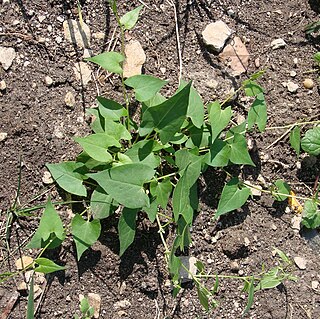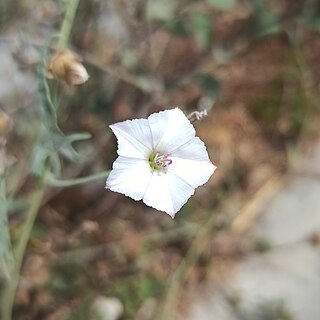
Convolvulaceae, commonly called the bindweeds or morning glories, is a family of about 60 genera and more than 1,650 species. These species are primarily herbaceous vines, but also include trees, shrubs and herbs. The tubers of several species are edible, the best known of which is the sweet potato.

Convolvulus is a genus of about 200 to 250 species of flowering plants in the bindweed family Convolvulaceae, with a cosmopolitan distribution. Common names include bindweed and morning glory; both are names shared with other closely related genera.

Fallopia convolvulus, the black-bindweed or wild buckwheat, is a fast-growing annual flowering plant in the family Polygonaceae native throughout Europe, Asia and northern Africa.

Fallopia is a genus of about 12 species of flowering plants in the buckwheat family, often included in a wider treatment of the related genus Polygonum in the past, and previously including Reynoutria. The genus is native to temperate and subtropical regions of the Northern Hemisphere, but species have been introduced elsewhere. The genus includes species forming vines and shrubs.

Calystegia sepium is a species of flowering plant in the family Convolvulaceae. It has a subcosmopolitan distribution throughout temperate regions of the North and South hemispheres.

Convolvulus arvensis, or field bindweed, is a species of bindweed in the Convolvulaceae native to Europe and Asia. It is a rhizomatous and climbing or creeping herbaceous perennial plant with stems growing to 0.5–2 metres (1.6–6.6 ft) in length. It is usually found at ground level with small white and pink flowers.
Convolvulus kossmatii is a species of plant in the family Convolvulaceae. It is endemic to the island of Abd al Kuri in the Socotra archipelago of Yemen. Its natural habitat is subtropical or tropical dry shrubland.

Convolvulus tricolor is a species of flowering plant in the family Convolvulaceae, native to Mediterranean Europe. Common names include dwarf morning-glory, tricolour convolvulus, and belle de jour.

Convolvulus clementii, commonly known as desert bindweed, is a trailing perennial plant species, native to inland Australia. Mostly found on flat areas, like dune swales and claypans that are subject to seasonal inundation, in areas of open grassy woodland.

Bedellia somnulentella, the sweet potato leaf miner, is a moth in the family Bedelliidae.

Convolvulus erubescens, commonly known as blushing bindweed, or Australian bindweed, is a perennial herbaceous plant in the family Convolvulaceae that is endemic to Australia.
Convolvulus oxyphyllus is a species of flowering plant in the family Convolvulaceae, native to Iraq, Iran, Kuwait and Saudi Arabia. It was first described by Pierre Edmond Boissier in 1846.

Convolvulus equitans, commonly known as Texas bindweed, is a species of morning glory. It is native to the central and western United States and Mexico. Its overlapping petals give C. equitans its name; equitans being Latin for "riding on horseback".
Convolvulus aschersonii is a species of plant in the family Convolvulaceae. It is native to much of continental Africa as well as Madagascar.
Convolvulus erinaceus is a species of plant in the family Convolvulaceae. It is native to the Central Asia and the Near East.
Convolvulus fernandesii is a species of plant in the family Convolvulaceae. It is endemic to Portugal.

Convolvulus oleifolius is a species of plant in the family Convolvulaceae.

Convolvulus simulans is a species of annual plant in the morning glory family known as the small-flowered morning-glory and small-flowered bindweed. It is an inconspicuous vining plant that is characterized by tiny pale pink or pale blue bell-shaped flowers. It is typically restricted to clay and serpentine substrates in annual grassland, coastal sage scrub and chaparral habitats. This species is native to Arizona, California, and Baja California. Some taxonomies place this species under Convolvulus equitans.













